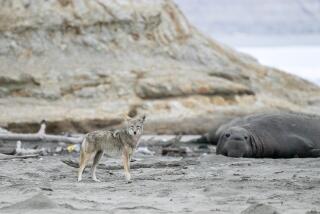Fossil Helps Scientists Trace Origin of Seals
- Share via
All of the world’s seals, sea lions and walruses originated from one common ancestor that branched off from the family line that gave rise to modern bears, scientists at San Diego State University, the Smithsonian Institution and American Museum of Natural History have concluded.
Reporting in the latest issue of Science magazine, the paleobiologists say that skeletal characteristics of a 23-million-year-old fossil found near Bakersfield indicate that the animals originated from this single fossil line, even though outwardly their modern descendants appear very different.
“The story of this particular fossil has suggested that it’s not just the closest ancestor of walruses and seals, but that it also is the ancestor of all pinnipeds. So that skunks and weasels and otters and things really have nothing to do with pinniped history,” said Annalisa Berta, one of the co-authors of the paper and a lecturer in the Biology Department at SDSU.
Similarities Are Shared
Known as pinnipeds, for “winged foot,” seals, sea lions and walruses until recently had been universally thought to have evolved from two different groups of animals, Berta said. It was believed that one ancient animal group gave rise to modern bears as well as sea lions, fur seals and walruses, and the other to true seals, weasels, otters and skunks, Berta said. True seals are those that propel themselves with their rear flippers and whose front flippers are virtually useless when they are on land.
However, analysis of the Bakersfield skeleton of Enaliarctos mealsi shows that it shares similarities in the skull, flippers and teeth with all modern pinnipeds, Berta said.
“It’s like an intermediate between bears and all pinnipeds,” Berta said. “It has flippers. There’s no question it was in the water, but, if you look at the teeth and some of the features of the skull, you can see that it had a bear ancestry.”
Other authors of the report with Berta are C. E. Ray, curator of paleobiology at the Smithsonian Institution, and A. R. Wyss, a graduate student at the American Museum of Natural History.
The skeletal comparison the scientists report was not possible before now because the Bakersfield fossil is the only nearly complete skeleton of Enaliarctos ever found. Previously, scientists had only isolated skulls or teeth of the animal to study.
“To really be able to put together the pieces of skeletal anatomy of pinnipeds, this specimen is like the Rosetta Stone,” Berta said. “Because it puts the head with the rest of the body. So now we don’t have to speculate about what the earliest pinnipeds looked like.”
Fossil Found Near Bakersfield
The fossil was discovered at Pyramid Hill near Bakersfield in 1975 by a private collector, the late D. R. Emlong, whose collection was acquired by the Smithsonian. Berta has been studying the collection under a grant from the National Science Foundation.
The animal was about the size of a male harbor seal, about 4 1/2 feet long and weighing 160 to 190 pounds, and lived in a shallow inland sea. Other fossils found nearby and in rock strata indicate its age is about 23 million years. Unlike modern pinnipeds, which rely primarily on their front or back flippers, Enaliarctos showed evidence of using both, indicating that it spent much more time on land than do its descendant pinnipeds, the scientists report.
Berta noted that two years ago Wyss, of the American Museum of Natural History, used skeletal comparisons between pinnipeds to propose that all of them originated from a common ancestor. There also has been some evidence of similarities in chromosomes and blood proteins. However, the skeleton provides more convincing proof, she said.
More to Read
Sign up for Essential California
The most important California stories and recommendations in your inbox every morning.
You may occasionally receive promotional content from the Los Angeles Times.









